Geography Playlist
19 chapters • 0 completed
The Universe and the Earth
18 topics
Atmosphere and its composition
6 topics
Atmospheric Temperature
11 topics
Atmospheric Moisture
9 topics
Air Mass, Fronts & Cyclones
15 topics
Evolution of Earths Crust, Earthquakes and Volcanoes
23 topics
Interior of The Earth
14 topics
Landforms
25 topics
Geomorphic Processes
10 topics
Movement of Ocean Water
16 topics
Oceans and its Properties
12 topics
Climate of a Region
14 topics
Indian Geography - introduction, Geology
5 topics
Physiography of India
27 topics
Indian Climate
20 topics
Indian Drainage
32 topics
Soil and Natural Vegetation
13 topics
Mineral and Energy Resources, Industries in India
28 topics
Indian Agriculture
22 topics
Chapter 6: Evolution of Earths Crust, Earthquakes and Volcanoes
Chapter TestContinental Drift Theory
Continental Drift Theory, proposed by Alfred Wegener in 1912, was the first attempt to explain the movement of continents and the present arrangement of continents and ocean basins. It suggested that all continents were once united into a single supercontinent 'Pangaea', surrounded by a vast ocean 'Panthalassa'.
Continental Drift Theory, proposed by Alfred Wegener in 1912, was the first attempt to explain the movement of continents and the present arrangement of continents and ocean basins. It suggested that all continents were once united into a single supercontinent 'Pangaea', surrounded by a vast ocean 'Panthalassa'.
Key Elements of Wegener's Theory
| Element | Description |
|---|---|
| Pangaea | Supercontinent consisting of all present continents joined together. |
| Panthalassa | Vast global ocean surrounding Pangaea. |
| Drift | Slow movement of landmasses over Earth's surface. |
Mains Key Points
Prelims Strategy Tips
Split of Pangaea and Continental Drift
Wegener’s Continental Drift Theory (1912) proposed that the supercontinent Pangaea broke apart about 200 million years ago into Laurasia (north) and Gondwanaland (south), separated by the Tethys Sea. These masses drifted equatorward and westward, forming today’s continents, mountains, and oceans.
Wegener’s Continental Drift Theory (1912) proposed that the supercontinent Pangaea broke apart about 200 million years ago into Laurasia (north) and Gondwanaland (south), separated by the Tethys Sea. These masses drifted equatorward and westward, forming today’s continents, mountains, and oceans.
Timeline of Pangaea Split
| Era/Period | Event |
|---|---|
| Triassic (~250 mya) | Pangaea intact, surrounded by Panthalassa Ocean. |
| Jurassic (~200 mya) | Pangaea split into Laurasia and Gondwanaland. |
| Cretaceous (~145 mya) | Laurasia and Gondwanaland further broke into present-day continents. |
| Cenozoic (~65 mya-present) | Continents drift to current positions; Himalayas and Alps formed. |
Evidences for Continental Drift
| Evidence | Description | Example |
|---|---|---|
| Fit of continents | Coastlines match like puzzle pieces | Africa–South America |
| Fossil evidence | Identical fossils on different continents | Glossopteris, Mesosaurus |
| Geological evidence | Similar rock formations & mountains | Appalachians–Caledonides |
| Glacial deposits | Same glacial marks in different continents | Africa, India, Australia |
Mains Key Points
Prelims Strategy Tips
Evidence Supporting the Continental Drift Theory
Alfred Wegener’s Continental Drift Theory (1912) proposed that continents were once united as Pangaea and later drifted apart. Multiple geological, paleontological, and climatic evidences supported this idea, but lack of a mechanism weakened its acceptance until Plate Tectonics provided the missing link.
Alfred Wegener’s Continental Drift Theory (1912) proposed that continents were once united as Pangaea and later drifted apart. Multiple geological, paleontological, and climatic evidences supported this idea, but lack of a mechanism weakened its acceptance until Plate Tectonics provided the missing link.
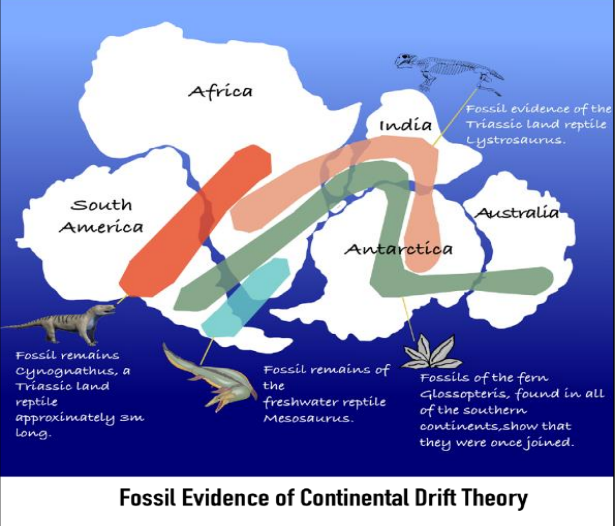
Evidences for Continental Drift
| Evidence | Description | Example |
|---|---|---|
| Jigsaw Fit | Continents fit together | S. America & Africa |
| Paleoclimate | Coal in mid-latitudes indicates past tropics | USA, Europe, China |
| Fossils | Same fossils across oceans | Mesosaurus, Glossopteris |
| Geological | Rock formations match | Appalachians & Scotland |
| Tillite Deposits | Glacial deposits in tropics | India, Antarctica |
| Polar Wandering | Different paleomagnetic poles | Europe vs N. America |
Continental Drift vs Plate Tectonics
| Aspect | Continental Drift | Plate Tectonics |
|---|---|---|
| Origin | Proposed by Wegener (1912) | Developed in 1960s (Hess, Vine & Matthews) |
| Driving Mechanism | Not explained (tidal forces, Earth rotation) | Mantle convection, ridge push, slab pull |
| Evidence | Jigsaw fit, fossils, paleoclimate, glacial tillite | Seafloor spreading, paleomagnetism, ocean drilling |
| Scope | Focused only on continental drift | Explains movement of both continental and oceanic plates |
| Acceptance | Initially rejected | Universally accepted, modern theory of lithosphere |
Mains Key Points
Prelims Strategy Tips
Convection Current Theory & Sea Floor Spreading
Arthur Holmes suggested mantle convection currents as the mechanism behind continental drift. Harry Hess and Robert Dietz later proposed Sea Floor Spreading, showing new crust forms at mid-ocean ridges and old crust subducts at trenches. Together these laid the foundation for Plate Tectonic Theory.
Arthur Holmes suggested mantle convection currents as the mechanism behind continental drift. Harry Hess and Robert Dietz later proposed Sea Floor Spreading, showing new crust forms at mid-ocean ridges and old crust subducts at trenches. Together these laid the foundation for Plate Tectonic Theory.
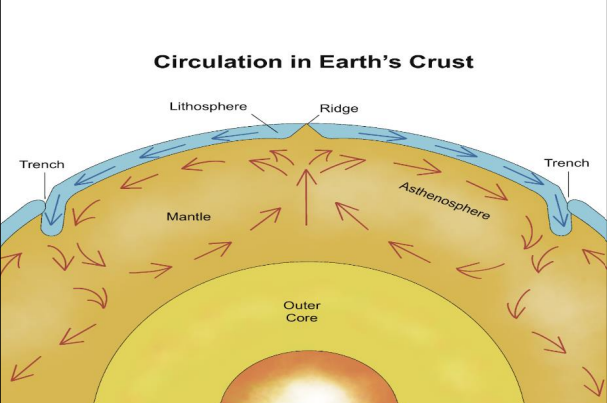
Comparison: Convection Current Theory vs Sea Floor Spreading
| Aspect | Convection Current Theory | Sea Floor Spreading |
|---|---|---|
| Propounder | Arthur Holmes (1930s) | Harry Hess & R.S. Dietz (1960s) |
| Basis | Mantle convection from radioactive heat | Ocean ridges volcanism & trench subduction |
| Focus | Explains mechanism of drift | Explains ocean crust creation & destruction |
| Evidence | Conceptual, weak proof initially | Magnetic anomalies, ocean drilling, heat flow |
| Contribution | Provided mechanism for drift | Confirmed drift, led to Plate Tectonics |
Mains Key Points
Prelims Strategy Tips
Evidences for Seafloor Spreading & Theory of Plate Tectonics
Seafloor spreading was confirmed through geological, geophysical, and paleomagnetic evidence, providing the foundation for Plate Tectonic Theory. The theory explains Earth's lithosphere as divided into plates that move over the asthenosphere, shaping continents, oceans, and mountains.
Seafloor spreading was confirmed through geological, geophysical, and paleomagnetic evidence, providing the foundation for Plate Tectonic Theory. The theory explains Earth's lithosphere as divided into plates that move over the asthenosphere, shaping continents, oceans, and mountains.
Evidence Supporting Seafloor Spreading
| Evidence | Observation | Significance |
|---|---|---|
| Ocean Floor Geology | Mid-ocean ridges, trenches, volcanoes | Dynamic oceanic crust formation |
| Age of Rocks | Younger at ridges, older away | Progressive seafloor creation |
| Sediment Thickness | Thicker farther from ridge | Supports older crust away from ridges |
| Paleomagnetism | Symmetrical magnetic striping | Direct proof of spreading |
| Heat Flow | High at ridges, low at trenches | Indicates magma activity |
| Seismicity & Volcanism | Concentrated at ridges/trenches | Supports ridge-spread & subduction |
Plate Tectonic Theory - Key Postulates
| Aspect | Explanation |
|---|---|
| Lithosphere | Divided into rigid plates |
| Asthenosphere | Plates float/move over viscous mantle layer |
| Plate Boundaries | Zones of interaction, earthquakes, volcanoes |
| Driving Forces | Convection currents, slab pull, ridge push, mantle plumes |
| Processes Explained | Drift, spreading, subduction, mountain building |
Mains Key Points
Prelims Strategy Tips
Plates and Plate Movement
Earth’s lithosphere is broken into rigid plates that float over the semi-molten asthenosphere. These plates move due to mantle convection currents, slab-pull, and ridge-push, leading to continental drift, earthquakes, volcanism, and mountain building.
Earth’s lithosphere is broken into rigid plates that float over the semi-molten asthenosphere. These plates move due to mantle convection currents, slab-pull, and ridge-push, leading to continental drift, earthquakes, volcanism, and mountain building.
Major Tectonic Plates
| Plate Name | Type | Extent |
|---|---|---|
| Pacific Plate | Oceanic | Largest, covers Pacific Ocean |
| North American Plate | Continental + Oceanic | North America + western Atlantic floor |
| South American Plate | Continental + Oceanic | South America + western Atlantic floor |
| Eurasian Plate | Continental + Oceanic | Europe, Asia (except Indian subcontinent), adjoining ocean floor |
| African Plate | Continental + Oceanic | Africa + eastern Atlantic floor |
| Indo-Australian Plate | Continental + Oceanic | India, Australia, New Zealand, Indian Ocean |
| Antarctic Plate | Continental + Oceanic | Antarctica + surrounding ocean floor |
Minor Tectonic Plates
| Plate Name | Location |
|---|---|
| Cocos Plate | Between Central America and Pacific |
| Nazca Plate | Between South America and Pacific |
| Arabian Plate | Arabian Peninsula |
| Philippine Plate | Between Asia and Pacific |
| Caroline Plate | North of New Guinea |
| Fiji Plate | Northeast of Australia |
| Juan de Fuca Plate | Southeast of North America |
Mains Key Points
Prelims Strategy Tips
Plate Margins and Plate Boundaries
Plate margins are the edges of tectonic plates, while plate boundaries are dynamic zones where two plates interact. Depending on movement, boundaries can be convergent (destructive), divergent (constructive), or transform (conservative).
Plate margins are the edges of tectonic plates, while plate boundaries are dynamic zones where two plates interact. Depending on movement, boundaries can be convergent (destructive), divergent (constructive), or transform (conservative).
Types of Plate Boundaries
| Type | Movement | Landform/Features | Example |
|---|---|---|---|
| Convergent | Plates collide | Mountains, trenches, volcanoes | Himalayas, Andes, Mariana Trench |
| Divergent | Plates move apart | Mid-ocean ridges, rift valleys, new crust | Mid-Atlantic Ridge, East African Rift |
| Transform | Plates slide laterally | Faults, earthquakes | San Andreas Fault (USA), North Anatolian Fault (Turkey) |
Mains Key Points
Prelims Strategy Tips
Types of Plate Boundaries
Tectonic plate interactions occur as convergent, divergent, or transform boundaries. These interactions shape Earth's surface, forming mountains, trenches, volcanoes, and rift valleys.
Tectonic plate interactions occur as convergent, divergent, or transform boundaries. These interactions shape Earth's surface, forming mountains, trenches, volcanoes, and rift valleys.
Major Plate Boundary Types
| Type | Process | Landforms/Features | Examples |
|---|---|---|---|
| Ocean–Ocean Convergence | Denser oceanic plate subducts | Oceanic trench, volcanic island arcs | Mariana Trench, Philippines Arc |
| Continent–Continent Convergence | Collision, no subduction | Fold mountains | Himalayas, Alps |
| Divergent | Plates move apart, magma rises | Mid-ocean ridges, rift valleys | Mid-Atlantic Ridge, East African Rift |
| Transform | Plates slide horizontally | Fault lines, earthquakes | San Andreas Fault |
Mains Key Points
Prelims Strategy Tips
Evaluation of Plate Tectonic Theory & Related Theories
Plate Tectonic Theory is the most widely accepted theory that integrates earlier hypotheses like Continental Drift and Seafloor Spreading. It provides a comprehensive explanation for landform evolution, earthquakes, and volcanism.
Plate Tectonic Theory is the most widely accepted theory that integrates earlier hypotheses like Continental Drift and Seafloor Spreading. It provides a comprehensive explanation for landform evolution, earthquakes, and volcanism.
Comparison between Continental Drift, Seafloor Spreading and Plate Tectonic Theory
| Criteria | Continental Drift | Seafloor Spreading | Plate Tectonics |
|---|---|---|---|
| Propounded by | Alfred Wegener (1912) | Harry Hess (1960s) | McKenzie, Parker, Morgan, Le Pichon (1967-68) |
| Theory | Continents move | Seafloor spreads due to magma upwelling | Lithospheric plates (continental & oceanic) move horizontally |
| Forces of movement | Gravity, buoyancy, pole-fleeing forces | Mantle convection currents | Mantle convection currents |
| Evidences | Fossils, Tillite, polar wandering | Ocean relief, paleomagnetism, sediment thickness | Earthquakes, volcanoes, paleomagnetism |
| Significance | Foundation for seafloor spreading | Foundation for plate tectonics | Explains landforms, distribution of earthquakes & volcanoes |
Mains Key Points
Prelims Strategy Tips
Earthquakes
An earthquake is the sudden shaking or trembling of the earth’s surface caused by the release of energy from the interior of the Earth. This energy travels in all directions as seismic waves, with the greatest impact at the epicenter.
An earthquake is the sudden shaking or trembling of the earth’s surface caused by the release of energy from the interior of the Earth. This energy travels in all directions as seismic waves, with the greatest impact at the epicenter.
Classification of Earthquakes by Depth
| Type | Depth Range | Characteristics |
|---|---|---|
| Shallow-focus | < 70 km | Most destructive, common in collision zones |
| Intermediate-focus | 70–300 km | Moderate destruction, common in subduction zones |
| Deep-focus | 300–700 km | Least destructive, occurs in subduction zones |
Mains Key Points
Prelims Strategy Tips
Earthquake Measurement
Earthquakes are measured using instruments such as seismographs and seismometers, and evaluated in terms of magnitude (energy released) and intensity (damage caused). Different scales like Richter Scale and Modified Mercalli Intensity Scale are used for assessment.
Earthquakes are measured using instruments such as seismographs and seismometers, and evaluated in terms of magnitude (energy released) and intensity (damage caused). Different scales like Richter Scale and Modified Mercalli Intensity Scale are used for assessment.
Richter Scale Classification
| Magnitude | Description | Effect |
|---|---|---|
| 0–2.0 | Micro | Never felt by people, recorded only by instruments. |
| 2.0–2.9 | Minor | Felt slightly, generally not recorded without instruments. |
| 3.0–3.9 | Minor | Felt by people but no damage. |
| 4.0–4.9 | Light | Noticeable shaking; rattling of objects, minimal damage. |
| 5.0–5.9 | Moderate | Mild damage to weak structures, cracks in stronger buildings. |
| 6.0–6.9 | Strong | Severe shaking, damage up to 160 km from epicenter. |
| 7.0–7.9 | Major | Widespread severe damage across large areas. |
| 8.0–8.9 | Great | Can devastate areas beyond 100 miles. |
| 9.0–9.9 | Great | Catastrophic destruction across regions, tsunamis possible. |
| 10+ | Epic | Never recorded in history; theoretical level of destruction. |
Mains Key Points
Prelims Strategy Tips
Earthquake Measurement
Earthquakes are measured using instruments such as seismographs and seismometers, and evaluated in terms of magnitude (energy released) and intensity (damage caused). Different scales like Richter Scale and Modified Mercalli Intensity Scale are used for assessment.
Earthquakes are measured using instruments such as seismographs and seismometers, and evaluated in terms of magnitude (energy released) and intensity (damage caused). Different scales like Richter Scale and Modified Mercalli Intensity Scale are used for assessment.
Richter Scale Classification
| Magnitude | Description | Effect |
|---|---|---|
| 0–2.0 | Micro | Never felt by people, recorded only by instruments. |
| 2.0–2.9 | Minor | Felt slightly, generally not recorded without instruments. |
| 3.0–3.9 | Minor | Felt by people but no damage. |
| 4.0–4.9 | Light | Noticeable shaking; rattling of objects, minimal damage. |
| 5.0–5.9 | Moderate | Mild damage to weak structures, cracks in stronger buildings. |
| 6.0–6.9 | Strong | Severe shaking, damage up to 160 km from epicenter. |
| 7.0–7.9 | Major | Widespread severe damage across large areas. |
| 8.0–8.9 | Great | Can devastate areas beyond 100 miles. |
| 9.0–9.9 | Great | Catastrophic destruction across regions, tsunamis possible. |
| 10+ | Epic | Never recorded in history; theoretical level of destruction. |
Modified Mercalli Intensity (MMI) Scale
| Intensity | Description |
|---|---|
| I | Instrumental: detected only by instruments. |
| II | Very feeble: felt only by people at rest. |
| III | Slight: like the passing of a truck, felt indoors. |
| IV | Moderate: perceptible by moving people; loose objects disturbed. |
| V | Rather strong: dishes broken, bells rung, pendulum clocks stopped. |
| VI | Strong: felt by all, some frightened; slight damage, plaster cracks. |
| VII | Very strong: noticed in vehicles, damage to poorly built structures. |
| VIII | Destructive: chimneys fall, heavy furniture overturned, damage widespread. |
| IX | Ruinous: great damage to substantial buildings, ground cracks, pipes broken. |
| X | Disastrous: many buildings destroyed. |
| XI | Very disastrous: few structures left standing. |
| XII | Catastrophic: total destruction, ground visibly waves. |
Mains Key Points
Prelims Strategy Tips
Causes of Earthquakes
Earthquakes are triggered by both natural geological processes and human activities. Natural causes include volcanicity, faulting, and plate tectonics, while anthropogenic causes involve mining, blasting, drilling, and reservoir-induced seismicity.
Earthquakes are triggered by both natural geological processes and human activities. Natural causes include volcanicity, faulting, and plate tectonics, while anthropogenic causes involve mining, blasting, drilling, and reservoir-induced seismicity.
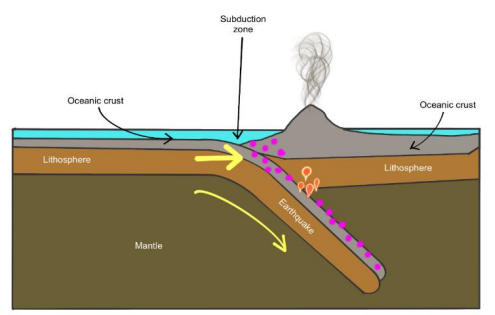
Types of Causes of Earthquakes
| Category | Process | Examples |
|---|---|---|
| Vulcanicity | Explosive volcanic eruptions releasing gases & magma | Krakatoa (1883), Nevado del Ruiz (1985) |
| Faulting | Sudden breaking/slipping of rocks along fault lines | San Francisco (1906), Bihar (1934), Guatemala (1975) |
| Plate Tectonics - Divergent | Seafloor spreading & crust contraction | Mid-Atlantic Ridge earthquakes |
| Plate Tectonics - Convergent | Subduction zones create deep Benioff Zone earthquakes | Alaska Good Friday (1964) |
| Plate Tectonics - Transform | Shallow quakes due to lateral sliding of plates | San Andreas Fault, California |
| Anthropogenic | Mining, drilling, nuclear tests, reservoir-induced pressure | Koyna Dam Earthquake (1967) |
Mains Key Points
Prelims Strategy Tips
Global Distribution of Earthquakes
Around 90% of earthquakes occur along plate boundaries, concentrated in a few major belts such as the Circum-Pacific (Ring of Fire), Mid-Atlantic, and Mid-Continental belts. Intra-plate earthquakes also occur but are less frequent.
Around 90% of earthquakes occur along plate boundaries, concentrated in a few major belts such as the Circum-Pacific (Ring of Fire), Mid-Atlantic, and Mid-Continental belts. Intra-plate earthquakes also occur but are less frequent.
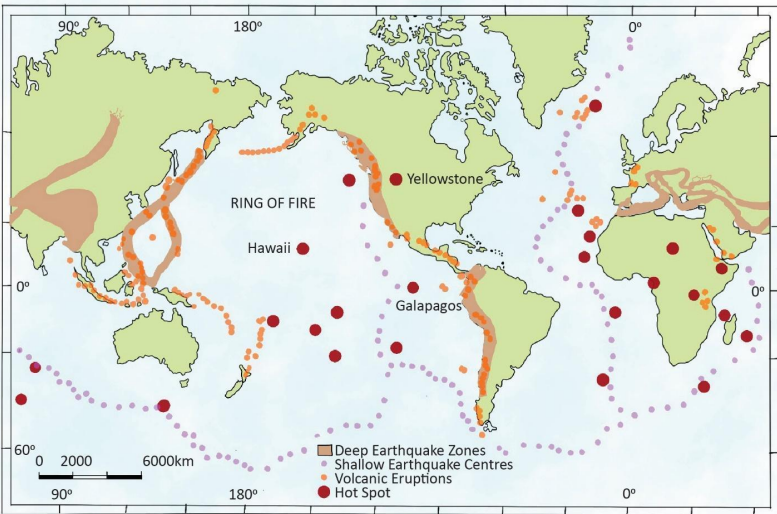
Global Earthquake Belts
| Belt/Zone | Location | Cause | Examples |
|---|---|---|---|
| Circum-Pacific (Ring of Fire) | Pacific margins (~40,000 km) | Subduction of Pacific Plate | Japan, Chile, Alaska, Philippines |
| Mid-Atlantic Belt | Mid-Atlantic Ridge, East Africa Rift | Seafloor spreading, divergence | Iceland, Azores, Red Sea Rift |
| Mid-Continental Belt | Mediterranean–Himalaya–Myanmar | Plate convergence (collision/subduction) | Turkey, Himalayas, Nepal |
| Intra-Plate | Within stable continental plates | Ancient rift faults, stress zones | Latur (India), New Madrid (USA) |
Mains Key Points
Prelims Strategy Tips
Distribution of Earthquakes in India
India is divided into seismic zones based on the intensity of earthquakes experienced and the presence of active faults. The Seismic Zonation Map is prepared by the Bureau of Indian Standards (BIS).
India is divided into seismic zones based on the intensity of earthquakes experienced and the presence of active faults. The Seismic Zonation Map is prepared by the Bureau of Indian Standards (BIS).
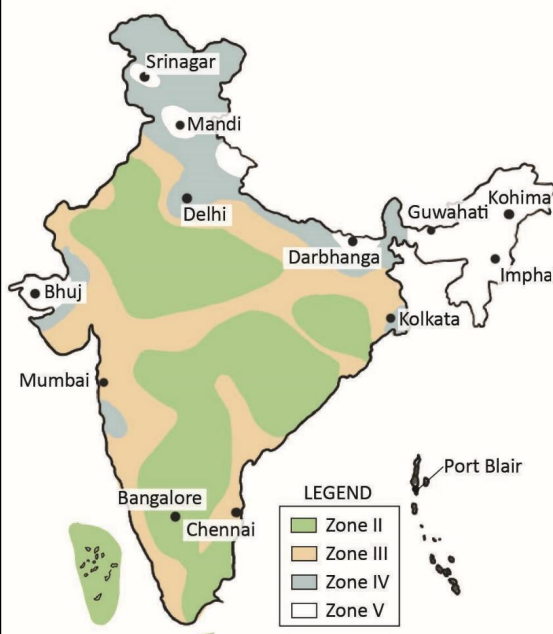
Seismic Zones of India
| Zone | Regions | Risk Level | Examples |
|---|---|---|---|
| Zone V | Kashmir, Himalayas, NE India, Rann of Kutch, Andamans | Very High | 2001 Bhuj, 1950 Assam |
| Zone IV | Delhi, J&K, Himachal, Sikkim, North UP, Bihar, WB, Gujarat parts | High | 2005 Kashmir, Bihar quakes |
| Zone III | Kerala, Goa, Lakshadweep, Central & South India states | Moderate | 1993 Latur, 1997 Jabalpur |
| Zone II | Remaining stable shield areas | Low | Occasional intra-plate quakes |
Mains Key Points
Prelims Strategy Tips
Consequences of Earthquakes
Earthquakes cause widespread destruction through landslides, ground deformation, and secondary hazards like tsunamis. Their impact varies from local structural damage to global-scale disasters.
Earthquakes cause widespread destruction through landslides, ground deformation, and secondary hazards like tsunamis. Their impact varies from local structural damage to global-scale disasters.
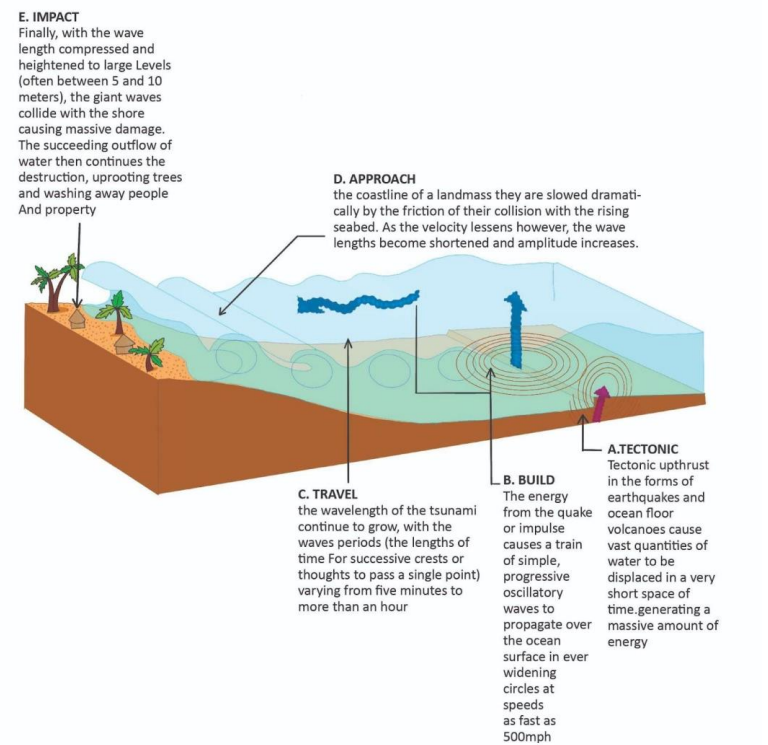
Major Consequences of Earthquakes
| Consequence | Cause | Example |
|---|---|---|
| Landslides | Seismic shocks destabilizing slopes | 1970 Peru earthquake |
| Ground deformation | Rising, subsidence, faulting | 1964 Alaska earthquake (10–15m displacement) |
| Tsunami | Seafloor displacement due to earthquake | 2004 Indian Ocean tsunami |
Mains Key Points
Prelims Strategy Tips
Volcanoes
Volcanoes are vents or fissures on Earth's surface through which magma, gases, and ashes erupt. They are directly linked to Earth's internal heat and tectonic processes.
Volcanoes are vents or fissures on Earth's surface through which magma, gases, and ashes erupt. They are directly linked to Earth's internal heat and tectonic processes.
Causes of Volcanic Eruptions
| Cause | Explanation | Example |
|---|---|---|
| Heating of Earth's Interior | Radioactive decay and primordial heat melt rocks forming magma. | Mantle plumes under Hawaii |
| Plate Tectonics - Convergent | Subduction of denser plate generates magma which erupts violently. | Andes Mountains, Japan |
| Plate Tectonics - Divergent | Magma rises through fissures at mid-ocean ridges forming new crust. | Mid-Atlantic Ridge |
| Steam Formation | Groundwater meets magma, turns into steam, causing explosive eruptions. | Krakatoa eruption (1883) |
Mains Key Points
Prelims Strategy Tips
Distribution of Volcanoes
Volcanoes are unevenly distributed across the globe, mostly concentrated along tectonic plate boundaries. About 80% of volcanoes are located at convergent plate boundaries, 15% at divergent boundaries, and the rest occur as intra-plate hotspots.
Volcanoes are unevenly distributed across the globe, mostly concentrated along tectonic plate boundaries. About 80% of volcanoes are located at convergent plate boundaries, 15% at divergent boundaries, and the rest occur as intra-plate hotspots.
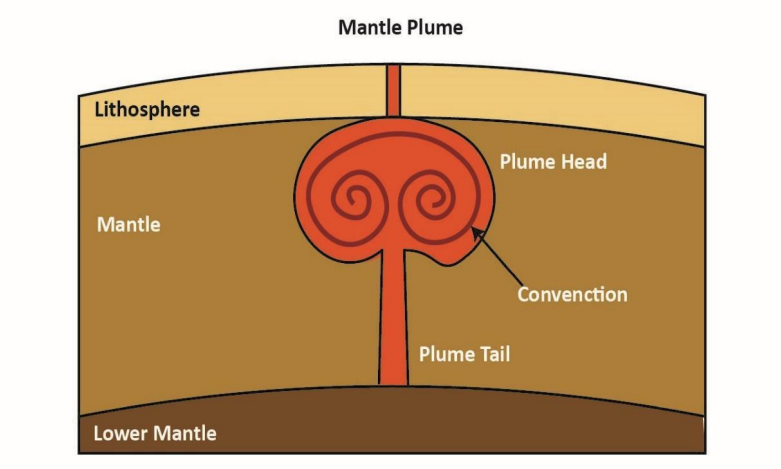
Global Volcanic Belts
| Belt | Location/Plates | Examples |
|---|---|---|
| Circum-Pacific (Ring of Fire) | Pacific margins, island arcs, subduction zones | Fujiyama (Japan), Mayon (Philippines), Kadovar (PNG) |
| Mid-Continental Belt | Mediterranean, Alpine chains, East African Rift | Etna, Stromboli, Kilimanjaro, Meru |
| Mid-Atlantic Ridge Belt | Mid-oceanic ridge between Americas and Eurasia-Africa | Iceland volcanoes |
| Intra-Plate (Hotspot) | Interior of plates, mantle plumes | Hawaiian Islands, Deccan Traps (Reunion Hotspot) |
Prelims Strategy Tips
Products of Volcanic Eruption
Volcanic eruptions release gases, fragmented materials (pyroclasts), and molten lava. The type of eruption depends on the opening (fissure or central vent) and the viscosity of the magma.
Volcanic eruptions release gases, fragmented materials (pyroclasts), and molten lava. The type of eruption depends on the opening (fissure or central vent) and the viscosity of the magma.
Products of Volcanic Eruption
| Product | Description | Example |
|---|---|---|
| Gases | Water vapor, CO2, SO2, H2S, etc. | Cause acid rain |
| Volcanic Blocks | >32 mm rock fragments | Thrown near vent |
| Lapilli / Cinders | 4–32 mm fragments | Scoria cones |
| Volcanic Ash | 0.25–4 mm fine particles | Covers wide areas |
| Volcanic Dust | <0.25 mm very fine | Suspended in atmosphere |
| Tuff | Compacted volcanic ash | Tuff rocks in Italy |
| Lava (Basic) | Low silica, fluid, peaceful eruption | Basalt (Deccan Traps) |
| Lava (Acidic) | High silica, viscous, explosive eruption | Andesitic volcanoes |
Prelims Strategy Tips
Types of Central Eruption
Central eruptions occur through a vent or mouth and vary from calm, non-explosive outflows to violent explosive eruptions. They are classified into Hawaiian, Strombolian, Vulcanian, Pelean, and Plinian types, depending on lava viscosity, gas content, and eruptive style.
Central eruptions occur through a vent or mouth and vary from calm, non-explosive outflows to violent explosive eruptions. They are classified into Hawaiian, Strombolian, Vulcanian, Pelean, and Plinian types, depending on lava viscosity, gas content, and eruptive style.
Types of Central Eruptions
| Type | Features | Examples |
|---|---|---|
| Hawaiian | Basic lava, calm eruption, rare explosions | Mauna Loa, Kilauea |
| Strombolian | Moderate, rhythmic, basaltic lava with gas bubbles | Stromboli (Italy) |
| Vulcanian | Moderately explosive, ash showers, cauliflower-shaped clouds | Mt. Vulcano (Lipari) |
| Pelean | Violent, pyroclastic flows, Nuees Ardentes | Mount Pelée (Martinique) |
| Plinian | Highly viscous lava, very violent, tall ash columns | Mount St. Helens, Vesuvius |
Mains Key Points
Prelims Strategy Tips
Volcanic Landforms
Volcanic activity produces diverse landforms depending on whether magma solidifies on the surface (extrusive) or below the surface (intrusive). Extrusive landforms include cones, craters, and plateaus, while intrusive landforms include batholiths, laccoliths, sills, dykes, and phacoliths.
Volcanic activity produces diverse landforms depending on whether magma solidifies on the surface (extrusive) or below the surface (intrusive). Extrusive landforms include cones, craters, and plateaus, while intrusive landforms include batholiths, laccoliths, sills, dykes, and phacoliths.
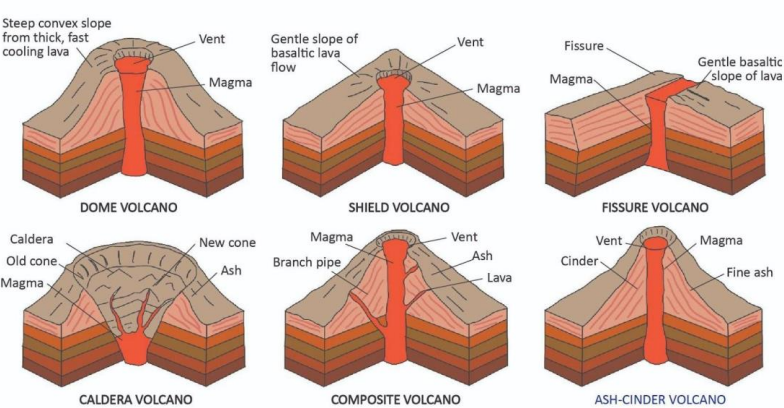
Extrusive Landforms of Central Eruption
| Landform | Characteristics | Examples |
|---|---|---|
| Cinder Cone | Small cones of ash and pyroclastics | Mt. Jorullo (Mexico) |
| Shield Volcano | Broad, gently sloping from fluid lava | Mauna Loa (Hawaii) |
| Composite Volcano | Stratified, steep-sided cone | Fujiyama, Cotopaxi, Vesuvius |
| Crater | Funnel-shaped depression, sometimes lake | Crater Lake, Lake Toba |
| Caldera | Large depression after summit collapse | Krakatoa Caldera |
Intrusive Volcanic Landforms
| Landform | Characteristics | Examples |
|---|---|---|
| Batholith | Largest irregular intrusive bodies | Sierra Nevada (USA) |
| Laccolith | Dome-shaped, pushes strata upward | Henry Mountains (Utah, USA) |
| Sill | Horizontal sheet between strata | Whin Sill (UK) |
| Dyke | Vertical/steep intrusion cutting layers | Deccan Trap Dykes (India) |
| Phacolith | Lens-shaped, in folds (anticline/syncline) | Found in Himalayas |
| Lopolith | Saucer-shaped, concave floor | Bushveld Complex (South Africa) |
| Volcanic Neck | Solidified magma in extinct vent | Devil’s Tower (USA) |
Mains Key Points
Prelims Strategy Tips
Intrusive Volcanic Landforms
Intrusive landforms form when magma solidifies beneath the Earth's surface. They cool slowly, producing coarse-grained igneous rocks. These features strongly influence mountain building, mineralization, and landscape evolution.
Intrusive landforms form when magma solidifies beneath the Earth's surface. They cool slowly, producing coarse-grained igneous rocks. These features strongly influence mountain building, mineralization, and landscape evolution.
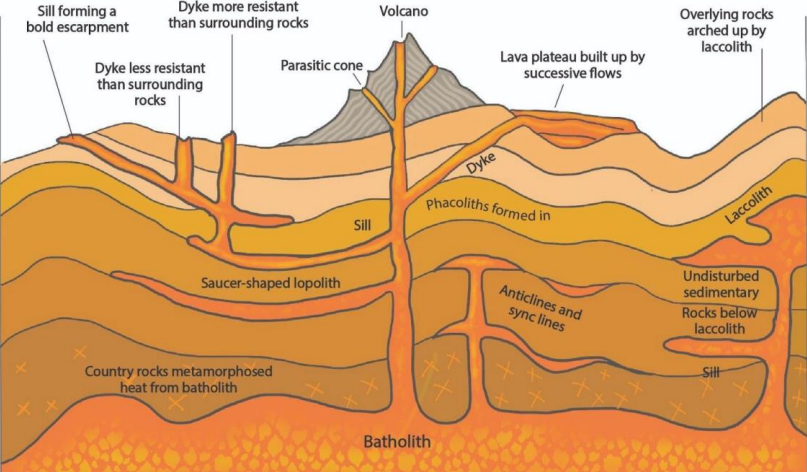
Types of Intrusive Landforms
| Landform | Nature | Key Features | Examples |
|---|---|---|---|
| Dyke | Discordant | Vertical wall-like intrusion | Chotanagpur Plateau, Cleveland Dyke (UK) |
| Sill | Concordant | Horizontal sheet parallel to strata | Great Whin Sill (UK), Deccan Sills (India) |
| Laccolith | Concordant | Dome-shaped intrusion uplifting strata | Henry Mountains (USA), Mt. Holmes |
| Lopolith | Concordant | Saucer-shaped, associated with mafic magma | Bushveld Complex (South Africa) |
| Phacolith | Concordant | Lens-shaped in folds | Himalayas, Alps |
| Batholith | Discordant | Massive dome-shaped granitic bodies | Sierra Nevada (USA), Aravalli (India) |
Comparison: Extrusive vs Intrusive Landforms
| Aspect | Extrusive | Intrusive |
|---|---|---|
| Formation | Lava cools on surface | Magma cools beneath surface |
| Cooling Rate | Rapid → fine-grained (basalt) | Slow → coarse-grained (granite) |
| Examples | Cinder cones, Shield volcanoes, Lava plateaus | Dykes, Sills, Laccoliths, Batholiths |
| Exposure | Directly visible | Exposed after erosion/denudation |
| Economic Importance | Basalt for roads, volcanic soils fertile | Granite, ores of platinum, chromium, vanadium |
Mains Key Points
Prelims Strategy Tips
Impact of Volcanic Eruptions
Volcanic eruptions are powerful natural events that reshape landscapes, influence climate, and affect human life. Their impacts can be both constructive (soil fertility, energy, tourism) and destructive (loss of life, lahars, climatic disruptions).
Volcanic eruptions are powerful natural events that reshape landscapes, influence climate, and affect human life. Their impacts can be both constructive (soil fertility, energy, tourism) and destructive (loss of life, lahars, climatic disruptions).
Impacts of Volcanic Eruptions
| Impact Type | Positive/Negative | Examples |
|---|---|---|
| Fertile Soil | Positive | Deccan Plateau, Java |
| Geothermal Energy | Positive | Iceland, New Zealand |
| Tourism | Positive | Mount Fuji, Vesuvius |
| Mineral Resources | Positive | Kimberlite (Diamonds), Sulfur, Copper |
| Loss of Life | Negative | Pompeii (79 AD), Nevado del Ruiz (1985) |
| Lahars | Negative | Mount Pinatubo (1991) |
| Pyroclastic Flows | Negative | Mount Pelée (1902) |
| Climate Cooling | Negative | Tambora (1815) |
| Air Transport Disruption | Negative | Eyjafjallajökull (2010) |
Mains Key Points
Prelims Strategy Tips
Chapter Complete!
Ready to move to the next chapter?
